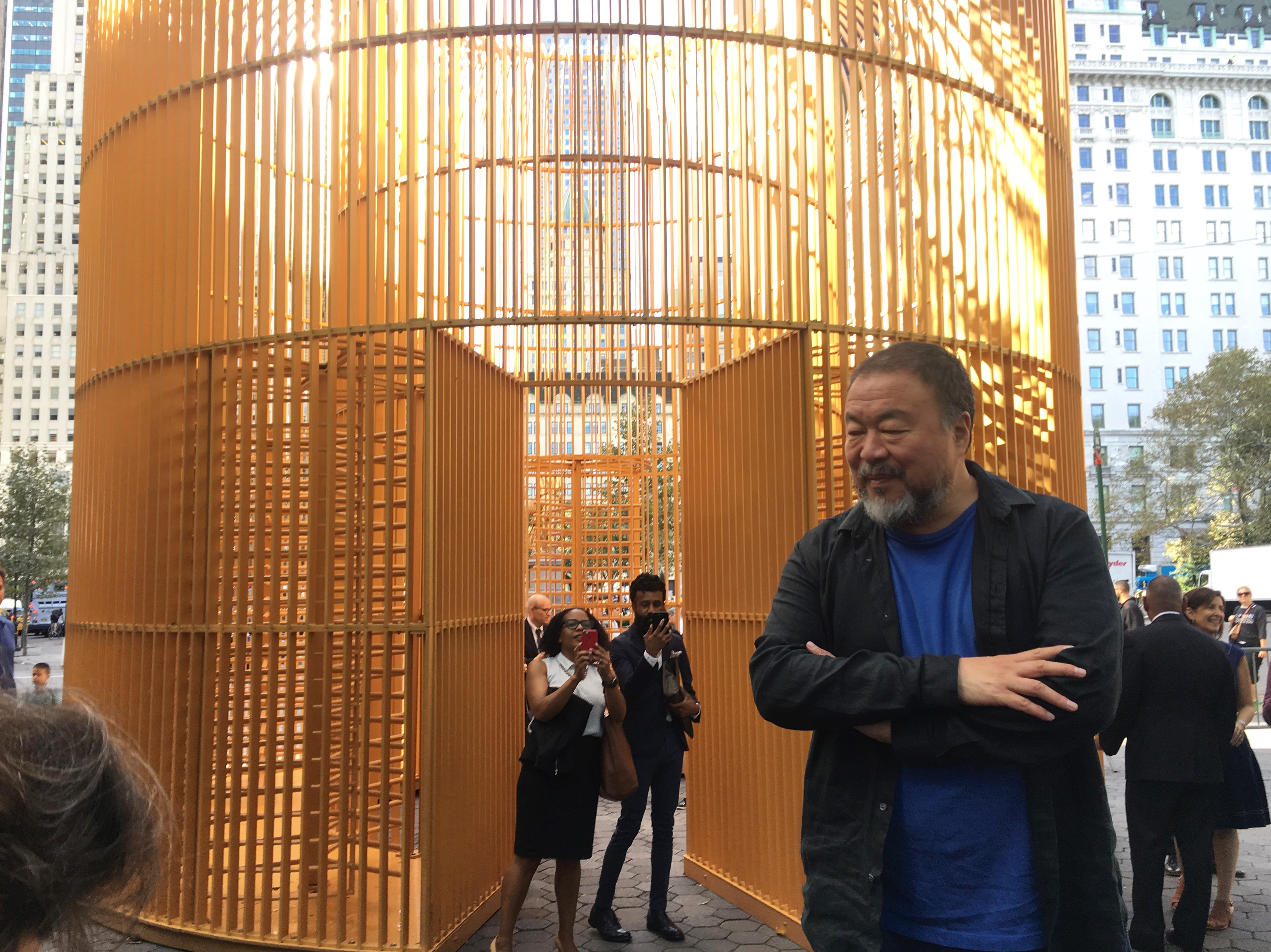It was a Tuesday in Midtown, and the Chinese artist-activist Ai Weiwei was standing in front of a giant, golden cage as tall as a palm tree. “Gilded Cage,” one aspect of Good Fences Make Good Neighbors, the artist’s new public exhibition, is eponymous: an ornate golden coop festooned with turnstiles and an open ceiling, at once claustrophobic, contemplative, and breathtaking. Speaking to a bevy of reporters thanks to the New York institution Public Art Fund, which had brought him for the occasion, Weiwei was characteristically calm and collected, almost blasé about the spectacle being held for him. “Fences or territory always relate to art, and also identity, and also understanding ourselves and our activity toward others,” he told us. “And in this time, they are of globalization, the economic, political landscape changed dramatically. But the fences and the territory became an even more urgent topic for everyone to be conscious and notice.”
Borders themselves are arbitrary and imaginary—just ask MIA. Fences are decidedly less so. Fences enforce the division in a real, physical way, enforcing an otherness as they exclude and insulate. The gaps and perforation of the fence allow the sight and knowledge of what’s just on the other side, without the ability to reach it. There’s no shortage of global crisis prompting citizens to slip past their home borders: North Africans attempting to transverse the Mediterranean Sea; Rohingya Muslims fleeing slaughter in Myanmar; Syrians being decimated by their own government; Palestinians held in siege for more than a generation. But the fence is what keeps them in place. Not for nothing does our own president want to construct a “beautiful wall” across the length of the dividing line between the U.S. and Mexico, in vain hopes it might hold people back.
Good Fences Make Good Neighbors is Weiwei’s largest public exhibition to date, spanning 300 sites across the city. Beyond “Gilded Cage,” other aspects include large-scale installations at Washington Square Park and Flushing Meadows, several more chain-link urban additions in the East Village (frustrating and confusing residents there), graphic installations on bus shelters throughout the city, a handful of newsstands in Manhattan, and a couple hundred banners on light posts throughout the city. These banners show photographs of notable dissidents and photos of refugees that Weiwei took as he journeyed through refugee camps in 2015. It was during these visits to displaced and devastated families across the world that Weiwei filmed his new film, Human Flow, a movie where Weiwei takes a brutal and firsthand look at the conditions the aforementioned refugees face. (It was released on October 13, just a few days after he held his Midtown press conference.)
In addition to the artworks and the film, two limited edition artworks by Weiwei were put up for sale on eBay. One is a $675 cast sculpture of the artist’s hand, middle finger up, referencing his Study of Perspective series where he photographed the gesture in front of monuments, landmarks, and other symbols of power. The other is a $100 print of silhouetted crowds fleeing war, encountering concertina fences, and taking to the sea en masse. The works are limited and exclusive to the eBay sale through October 27, and the proceeds reportedly go to charity—the Public Art Fund itself.
This is all good and well, but a look at the contributors list to Good Fences Make Good Neighbors reveals a common hypocrisy of the blue-chip art world—namely, the very forces the work rails against help to finance the work itself. Major contributors to the exhibition include Michael and Nicolai Frahm, Danish art-world It Boys who apparently subsist off a fortune bequeathed by their coffee baron father. Of greater interest is Peter Kraus, a finance honcho who earned tens of millions of dollars a year under his employment at Merrill Lynch and Goldman Sachs. He worked for Goldman for two decades, and collected a $25 million golden parachute after the 2008 financial bailout, which also earned him a subpoena from Governor Andrew Cuomo as he investigated the misappropriation of taxpayer funds. There are a few other Goldman ties among the financiers, as well as connections to Mitt Romney’s old haunt Bain Capital, the late Greek shipping magnate Stavros Niarchos (who made his fortune moving oil), the Department of Defense, and the Federal Enforcement Homeland Security Foundation.
Though the contributors to this project must be separated from their institutions proper, it is worth considering the institutions’ contributions to the refugee diaspora. “I think the refugee crisis is a global crisis, it’s a human crisis,” Weiwei said. “We cannot just say it’s a refugee crisis. It’s not regional, it’s not just happening in the Middle East. It also happens in Africa, in Bangladesh, in many, many other locations—caused by war but also caused by environmental problems, famine, and the longtime lacking of support of education, and birth control, all those issues, very complicated issues.” Whether that cause be energy or environment or greed or war, as Weiwei suggests, there is always some external force driving refugees from their homes. It is not debatable the U.S.-led war in Iraq was fought under false pretenses for the acquisition of oil. That conflict, and its corresponding violence in Afghanistan, is now thought to have contributed to the formation of the Islamic state and the destabilization of Syria. The United State’s support for Israel and the refusal to condemn the siege of Palestine is well documented; just last week, Richard Spencer cited Israel as an example of a white Ethno-state he hopes for the U.S.
In 2015, Goldman made a public show of donating about $3 million to the United Nations High Commissioner on Refugees. That same year, Kerry R. Bolton wrote in Foreign Policy Review that “Goldman Sachs is the primary corporate contributor in funding the Afro-Levantine demographic shift to Europe,” referring to a pattern and strategy of destabilization in the Eastern Mediterranean and Middle Eastern regions by the U.S. and Israel to incentivize Jihadism to the benefit of the West. Bolton noted that a Goldman exec described the motives behind such theoretical support of a flow of refugees into Europe, stating they provide labor and taxes. “Mobility of capital, goods, and information at low cost and lightning speed is, in a nutshell, the raison d’etre of globalization; what the globalists really want of the migrants,” Bolton writes. This is where humans are seen as commodity, rather than dignified beings.
It’s not easy to be cynical of refugee relief, but who is benefitting from this work? What exactly is the charitable cause here—the jobs given to those tasked with installing the three hundred banners throughout the city, or the construction of “Arch” at Washington Square and the “Circle Fence” surrounding the Unisphere out in Queens? These installations, devoid of context, are almost whimsical. The installations around bus stations in Brooklyn are barely considered art, among their viewers–they must be considered in conjunction with the film. This is beyond a pet cause for the artist and filmmaker: Weiwei, who has leveraged his critiques to become perhaps the most famous artist since Warhol, has done little but battle existing power structures, in his life and work. He himself was exiled, due to his poet father, at one year old, to the edge of the Gobi desert, under the rule of Mao Zedong and the tyranny of the Cultural Revolution. This struggle is ingrained in him from youth.
It is understandable, then, drawing from his own experience as a child refugee, that children are a particular focal point of Human Flow. Kids, despite their circumstance of these refugee camps, burst with curiosity and joy at the presence of a camera. It speaks to the necessity and power of simply being seen as a human in the struggle for recognition. Children of a certain age don’t have the knowledge required to know the tenets of freedom, which grants them a freedom borne of ignorance—a freedom, nonetheless.
This missive is disrupted by a shot of a child’s body, laying in the sand of Iraq, disemboweled and rotting under the desert sun, about halfway through the film. It is horrifying and sobering and stays with you well after the credits roll. The horror compels you to take action, to ensure this atrocity does not continue indefinitely. As the lights came up in the theater, I realized that none other than Anohni had weathered the documentary sitting next to me. The corollary between “Drone Bomb Me” and Human Flow makes perfect sense, given how explicitly she has grappled with the forces of imperialism in her music. She appeared characteristically meditative, clad all in black, as we left the theater.
“It does pose the question,” she said to me, “what can we do?”
I didn’t have an answer.





